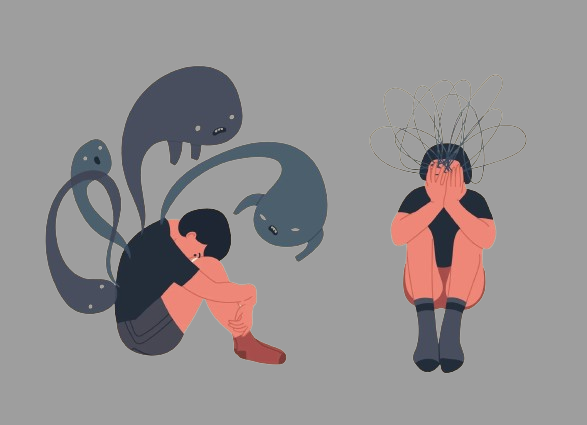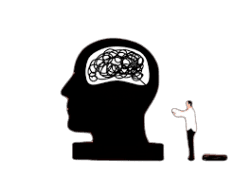A mental illness that severely impairs both your physical and emotional health is schizophrenia. It interferes with your ideas, memory, sensations, and behavior by upsetting the way your brain functions. You might so experience difficulties in many areas of your daily life. Your relationships, whether romantic, professional, or social, are frequently ruined by untreated schizophrenia. Additionally, it may make it difficult for you to organize your thoughts, and you may act in ways that increase your risk of becoming hurt or sick.
Schizophrenia
Schizophrenia is a severe mental illness characterized by abnormal reality interpretation. A mix of hallucinations, delusions, and severely abnormal thinking and behavior that can be debilitating can be symptoms of schizophrenia. These symptoms might interfere with day-to-day functioning.
Treatment for schizophrenic patients must last a lifetime. Early intervention could help manage symptoms before more significant issues arise and could enhance the prognosis in the long run.

Symptoms of schizophrenia
Numerous issues with thinking (cognition), behavior, and emotions are associated with schizophrenia. While there are many different signs and symptoms, they typically entail delusions, hallucinations, or disordered speech and indicate a decreased capacity for functioning. Among the symptoms could be:
Delusions
These misconceptions are unfounded and untrue. For instance, you may believe that you’re being hurt or harassed, that specific actions or remarks are meant for you, that you’re famous or gifted, that someone else is in love with you, or that a terrible accident is going to happen. For most persons with schizophrenia, delusions are present.
Hallucinations
Usually, these entail perceiving or hearing unreal phenomena. Nonetheless, a person suffering from schizophrenia experiences all the intensity and consequences of a typical event. Though they can occur in any sense, the most common type of hallucination is hearing voices.
Disorganized thinking (speech).
Chaotic speech suggests chaotic thought. Questions may not be fully or partially addressed, and effective communication may be compromised. On rare occasions, speech may consist of stringing together unintelligible words, a phenomenon frequently referred to as “word salad.”
incredibly disordered motor behavior.
This could manifest itself in a variety of ways, ranging from erratic excitement to childish foolishness. The lack of goal-focused behavior makes activities difficult to complete. Behavior examples include defying orders, acting in an improper
Negative symptoms
This is diminished or not able to perform normally. For instance, the individual can speak monotonously, avoid making eye contact, or exhibit signs of lack of emotion by changing their facial expressions or personal hygiene. In addition, the person can stop enjoying routine tasks, withdraw socially, or be incapable of enjoying themselves.
Over time, there may be phases when symptoms get worse and times when they get better. Certain symptoms might not go away.
Brain architecture associated with schizophrenia
The following brain regions have been linked to schizophrenia:
- Working memory, voluntary movement, speech, language, and executive processes including coordination are all controlled by the frontal lobe.
- Language, emotional emotions, and visual perception are all influenced by the temporal lobe. Another brain component connected to schizophrenia is the hippocampus, which is located in the temporal lobe. Learning and memory consolidation occur in the hippocampus.
Using an MRI, Turetsky et al. (1995) found that patients with schizophrenia had much reduced brain volume in the right and left frontal lobes. The findings suggest that the structural variations could account for the symptoms of schizophrenia. Additionally, research has shown that individuals with the condition had a much smaller hippocampus volume.
Heckers et al. (1998) found that during memory retrieval tests, patients with schizophrenia had increased activity in prefrontal brain areas and decreased activity in the hippocampus. Hyperfrontal activity has also been observed in other studies, which may help to explain why memory and concentration problems are common in people with schizophrenia (Soyka et al., 2005).

Theories of schizophrenia
Psychoanalytic theory:
When the ego has not yet separated from the id, schizophrenia is a retreat to the oral stage. Schizophrenics lose touch with the outside world when they regress to the primary narcissistic stage because they lack a distinct ego.Adolescence is a time of increased id impulses, particularly those that are sexual in character.
As Shanmugam notes, their increased sensitivity to behavior and criticism is the reason for their lack of libidinal attachment and absence of interpersonal relationships. Delusions, hallucinations, and cognitive disorders are identified as a result of an attempt to conform to the demands of the id impulses and maintain contact with some input.
Research by Bellack, Hunvich, and Geidman (1973) has demonstrated that an increase in id impulse is what causes ego impairment in people with schizophrenia.
Social learning theory of schizophrenia:
This idea states that schizophrenics react differently to the social environment than do normal people. Thus, schizophrenics’ lack of appropriate association and disruptions in their thinking processes result from a loss in attentiveness to their social surroundings.
Furthermore, a person who pays insufficient attention to social environment cues appears withdrawn. Ulman and Kreshmer (1965) asserted that the primary cause of schizophrenia is the reinforcement that a person experiences in a mental health facility. When patients exhibit illogical behavior and incomprehensible speech, hospital staff caters to them more attentively.
A highly criticized study was conducted to see if hospitalized patients might manipulate to make an impact on others by administering M.M.P.I. in an attempt to validate the social learning theory by Braginsky and Grosserking (1966).
“According to Cameron and Margaret (1949, 1951), people with schizophrenia are rigid in their own social roles and incapable of understanding the role-behavior of others. In order to shield oneself from societal expectations and demands, they therefore develop their own social role. Though there is a division between their inner and exterior identities, their inner selves’ ambitions, hopes, etc., might still be intact.
Experimental theory of schizophrenia:
Ronald Laing’s theory of schizophrenia views the disorder as a term for a particular set of troubling experiences and behaviors rather than as a disease. The experimental theory holds that rather than acknowledging a certain behavior as a potentially significant and helpful experience for the individual, the family is the ones who initially label it as schizophrenia.
According to him, schizophrenia is akin to a psychedelic tripper who need direction rather than control. From the perspective of the schizophrenic, it may be advantageous to adopt an attitude that views their illness as a pleasant experience.
Once they leave the institution, the schizophrenics will remain the same and lead a somewhat normal life. But there’s not a lot of proof in
Since schizophrenia is the most complicated functional psychosis, no one hypothesis has been able to adequately account for the extensive range of dysfunctions that are common to all forms of the disorder.
Duke and Nowicki (1979) claim that schizophrenia is a phenomenon so complicated and perplexing that scholars from a wide range of fields have collaborated to produce a comprehensive explanation. The results of research on the origins of schizophrenia are mostly disputed.
Nonetheless, a variety of theories have been put out to explain the genesis of schizophrenia. They are biological and psychological, or organic and functional. The treatment of these causes is the primary goal of their advancement.

Organic factors:
Biological factors:
Kraepelin was the one who initially categorized psychoses and claimed that schizophrenia is caused by a metabolic disease in which the glands are crucial. He said that by looking at the schizophrenia patients, his research had demonstrated this.
They claimed that the testicles and ovaries with schizophrenia decline. The theories of Kraepelin are supported by the writings of Mott, Gibbs, and Lewis. However, Moss believes that it might be a contributing element to one of the many causes of schizophrenia. She discovered that the gonads are microscopically normal in three or four schizophrenia cases, supporting her theory. Eventually, Kallman (1946) developed the theory that schizophrenia results from a genetic flaw.
Hereditary factors:
Numerous insightful studies on the genetic foundation of schizophrenia have been sparked by the increased prevalence of schizophrenia in the relatives of schizophrenic patients. According to statistics from Kallman (1953, 1958), there was a 16.3% incidence of schizophrenia in the families of schizophrenic patients for fraternal twins and 86.3% for identical twins.
According to genetic theories, schizophrenia is inherited physically. Fifty to sixty percent of persons with schizophrenia have a family history of mental disease. Using more sophisticated methods, Kringten (1967) conducted a follow-up study and found that the incidence rate for identical twins was 38% and for fraternal twins, 10%.
Neurophysiological factors and stress
Numerous studies on the excitation-inhibition balance of the nervous system have been conducted as a result of Pavlov’s theory that schizophrenia sufferers have hyperexcited nervous systems. According to Pavlov, a neural system deficiency that causes a state of partial inhibition is what causes schizophrenia.
This could lead to anomalies in the autonomic nervous system’s operation. Because of inhibition, the brain reacts to both strong and weak stimuli in the same way, giving weak stimuli the same power as strong ones. Because of this, he finds it difficult to discern between what is relevant and what is unneeded, and as a result, he confuses reality with fiction.
When the person can no longer tell the difference between fact and fiction, they ultimately become detached from reality. In the end, this results in a variety of hallucinations.



